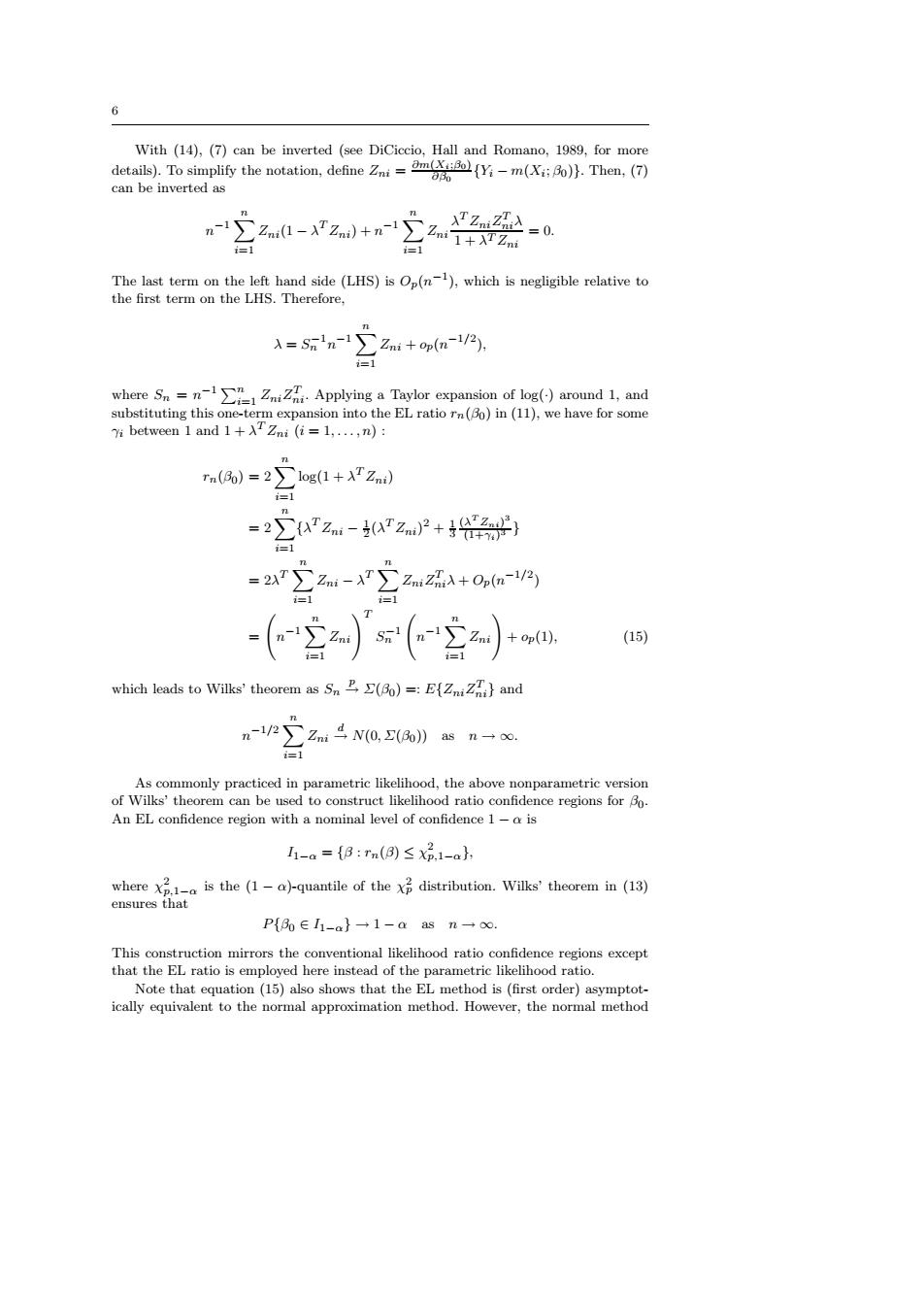正在加载图片...

6 With (14),(7)can be inverted (see DiCiccio,Hall and Romano,1989,for more details).To simplify the notation,definem-m()).Then,(7) 8那6 can be inverted as ZZ2=0. i=1 i=1 The last term on the left hand side(LHS)is Op(n),which is negligible relative to the first term on the LHS.Therefore, A=Sn'n-1>Zni+op(n-1/2). where SApplying a Taylor expansion of log()around 1,and substituting this one-term expansion into the EL ratio rn(B0)in (11),we have for some Yi between 1 and 1+TZni (i=1,...,n): rn(o)=2∑1og1+ATZn) i=1 =2∑azi-azn2+=} =1 =2xT∑Zni-T∑ZizA+0pm-1/2) i=1 1 (15) which leads to Wilks'theorem as Sn (Bo)=:EfZniZni}and n-1/2∑Zni4N(0,(6》asn-o. i-1 As commonly practiced in parametric likelihood,the above nonparametric version of Wilks'theorem can be used to construct likelihood ratio confidence regions for Bo. An EL confidence region with a nominal level of confidence 1-o is h-a={3:rn(g)≤X2-a, whereis the (1-a)-quantile of thedistribution.Wilks'theorem in (13) ensures that P{0∈I1-a}一1-aasn-o. This construction mirrors the conventional likelihood ratio confidence regions except that the EL ratio is employed here instead of the parametric likelihood ratio. Note that equation (15)also shows that the EL method is (first order)asymptot- ically equivalent to the normal approximation method.However,the normal method6 With (14), (7) can be inverted (see DiCiccio, Hall and Romano, 1989, for more details). To simplify the notation, define Zni = ∂m(Xi;β0) ∂β0 {Yi − m(Xi ; β0)}. Then, (7) can be inverted as n −1Xn i=1 Zni(1 − λ TZni) + n −1Xn i=1 Zni λ TZniZ T niλ 1 + λTZni = 0. The last term on the left hand side (LHS) is Op(n −1 ), which is negligible relative to the first term on the LHS. Therefore, λ = S −1 n n −1Xn i=1 Zni + op(n −1/2 ), where Sn = n −1 Pn i=1 ZniZ T ni. Applying a Taylor expansion of log(·) around 1, and substituting this one-term expansion into the EL ratio rn(β0) in (11), we have for some γi between 1 and 1 + λ TZni (i = 1, . . . , n) : rn(β0) = 2Xn i=1 log(1 + λ TZni) = 2Xn i=1 {λ T Zni − 1 2 (λ TZni) 2 + 1 3 (λ T Zni) 3 (1+γi) 3 } = 2λ T Xn i=1 Zni − λ T Xn i=1 ZniZ T niλ + Op(n −1/2 ) = n −1Xn i=1 Zni!T S −1 n n −1Xn i=1 Zni! + op(1), (15) which leads to Wilks’ theorem as Sn p→ Σ(β0) =: E{ZniZ T ni} and n −1/2Xn i=1 Zni d→ N(0, Σ(β0)) as n → ∞. As commonly practiced in parametric likelihood, the above nonparametric version of Wilks’ theorem can be used to construct likelihood ratio confidence regions for β0. An EL confidence region with a nominal level of confidence 1 − α is I1−α = {β : rn(β) ≤ χ 2 p,1−α}, where χ 2 p,1−α is the (1 − α)-quantile of the χ 2 p distribution. Wilks’ theorem in (13) ensures that P{β0 ∈ I1−α} → 1 − α as n → ∞. This construction mirrors the conventional likelihood ratio confidence regions except that the EL ratio is employed here instead of the parametric likelihood ratio. Note that equation (15) also shows that the EL method is (first order) asymptotically equivalent to the normal approximation method. However, the normal method